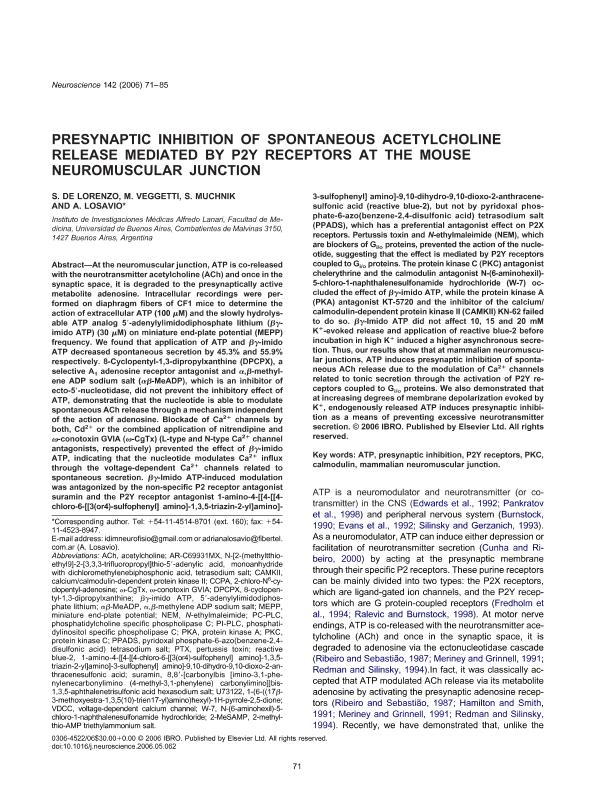Mostrar el registro sencillo del ítem
dc.contributor.author
de Lorenzo, María Soledad

dc.contributor.author
Veggetti, Mariela Iris

dc.contributor.author
Muchnik, Salomon

dc.contributor.author
Losavio, Adriana Silvia

dc.date.available
2020-06-17T19:28:39Z
dc.date.issued
2006-09
dc.identifier.citation
de Lorenzo, María Soledad; Veggetti, Mariela Iris; Muchnik, Salomon; Losavio, Adriana Silvia; Presynaptic inhibition of spontaneous acetylcholine release mediated by P2Y receptors at the mouse neuromuscular junction; Pergamon-Elsevier Science Ltd; Neuroscience; 142; 1; 9-2006; 71-85
dc.identifier.issn
0306-4522
dc.identifier.uri
http://hdl.handle.net/11336/107559
dc.description.abstract
At the neuromuscular junction, ATP is co-released with the neurotransmitter acetylcholine (ACh) and once in the synaptic space, it is degraded to the presynaptically active metabolite adenosine. Intracellular recordings were performed on diaphragm fibers of CF1 mice to determine the action of extracellular ATP (100 μM) and the slowly hydrolysable ATP analog 5′-adenylylimidodiphosphate lithium (βγ-imido ATP) (30 μM) on miniature end-plate potential (MEPP) frequency. We found that application of ATP and βγ-imido ATP decreased spontaneous secretion by 45.3% and 55.9% respectively. 8-Cyclopentyl-1,3-dipropylxanthine (DPCPX), a selective A1 adenosine receptor antagonist and α,β-methylene ADP sodium salt (αβ-MeADP), which is an inhibitor of ecto-5′-nucleotidase, did not prevent the inhibitory effect of ATP, demonstrating that the nucleotide is able to modulate spontaneous ACh release through a mechanism independent of the action of adenosine. Blockade of Ca2+ channels by both, Cd2+ or the combined application of nitrendipine and ω-conotoxin GVIA (ω-CgTx) (L-type and N-type Ca2+ channel antagonists, respectively) prevented the effect of βγ-imido ATP, indicating that the nucleotide modulates Ca2+ influx through the voltage-dependent Ca2+ channels related to spontaneous secretion. βγ-Imido ATP-induced modulation was antagonized by the non-specific P2 receptor antagonist suramin and the P2Y receptor antagonist 1-amino-4-[[4-[[4-chloro-6-[[3(or4)-sulfophenyl] amino]-1,3,5-triazin-2-yl]amino]-3-sulfophenyl] amino]-9,10-dihydro-9,10-dioxo-2-anthracenesulfonic acid (reactive blue-2), but not by pyridoxal phosphate-6-azo(benzene-2,4-disulfonic acid) tetrasodium salt (PPADS), which has a preferential antagonist effect on P2X receptors. Pertussis toxin and N-ethylmaleimide (NEM), which are blockers of Gi/o proteins, prevented the action of the nucleotide, suggesting that the effect is mediated by P2Y receptors coupled to Gi/o proteins. The protein kinase C (PKC) antagonist chelerythrine and the calmodulin antagonist N-(6-aminohexil)-5-chloro-1-naphthalenesulfonamide hydrochloride (W-7) occluded the effect of βγ-imido ATP, while the protein kinase A (PKA) antagonist KT-5720 and the inhibitor of the calcium/calmodulin-dependent protein kinase II (CAMKII) KN-62 failed to do so. βγ-Imido ATP did not affect 10, 15 and 20 mM K+-evoked release and application of reactive blue-2 before incubation in high K+ induced a higher asynchronous secretion. Thus, our results show that at mammalian neuromuscular junctions, ATP induces presynaptic inhibition of spontaneous ACh release due to the modulation of Ca2+ channels related to tonic secretion through the activation of P2Y receptors coupled to Gi/o proteins. We also demonstrated that at increasing degrees of membrane depolarization evoked by K+, endogenously released ATP induces presynaptic inhibition as a means of preventing excessive neurotransmitter secretion.
dc.format
application/pdf
dc.language.iso
eng
dc.publisher
Pergamon-Elsevier Science Ltd

dc.rights
info:eu-repo/semantics/openAccess
dc.rights.uri
https://creativecommons.org/licenses/by-nc-sa/2.5/ar/
dc.subject
ATP
dc.subject
PRESYNAPTIC INHIBITION
dc.subject
P2Y RECEPTORS
dc.subject
MAMMALIAN NEUROMUSCULAR JUNCTION
dc.subject.classification
Neurociencias

dc.subject.classification
Medicina Básica

dc.subject.classification
CIENCIAS MÉDICAS Y DE LA SALUD

dc.title
Presynaptic inhibition of spontaneous acetylcholine release mediated by P2Y receptors at the mouse neuromuscular junction
dc.type
info:eu-repo/semantics/article
dc.type
info:ar-repo/semantics/artículo
dc.type
info:eu-repo/semantics/publishedVersion
dc.date.updated
2020-05-27T16:40:10Z
dc.journal.volume
142
dc.journal.number
1
dc.journal.pagination
71-85
dc.journal.pais
Países Bajos

dc.journal.ciudad
Amsterdam
dc.description.fil
Fil: de Lorenzo, María Soledad. Universidad de Buenos Aires. Facultad de Medicina. Instituto de Investigaciones Médicas; Argentina
dc.description.fil
Fil: Veggetti, Mariela Iris. Universidad de Buenos Aires. Facultad de Medicina. Instituto de Investigaciones Médicas; Argentina. Consejo Nacional de Investigaciones Científicas y Técnicas; Argentina
dc.description.fil
Fil: Muchnik, Salomon. Consejo Nacional de Investigaciones Científicas y Técnicas; Argentina. Universidad de Buenos Aires. Facultad de Medicina. Instituto de Investigaciones Médicas; Argentina
dc.description.fil
Fil: Losavio, Adriana Silvia. Consejo Nacional de Investigaciones Científicas y Técnicas. Oficina de Coordinación Administrativa Houssay. Instituto de Investigaciones Médicas. Universidad de Buenos Aires. Facultad de Medicina. Instituto de Investigaciones Médicas; Argentina
dc.journal.title
Neuroscience

dc.relation.alternativeid
info:eu-repo/semantics/altIdentifier/url/https://www.sciencedirect.com/science/article/abs/pii/S0306452206007500
dc.relation.alternativeid
info:eu-repo/semantics/altIdentifier/doi/https://doi.org/10.1016/j.neuroscience.2006.05.062
Archivos asociados
